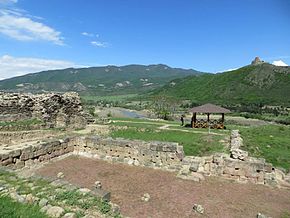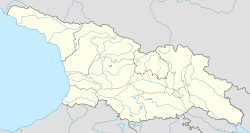Armazi

The ruins of a six-column hall in the Armazi palace on Mt. Bagineti (1st century BC).
|
|
| Location | Kartli, Georgia |
|---|---|
| Coordinates | 41°49′N 44°40′E / 41.817°N 44.667°ECoordinates: 41°49′N 44°40′E / 41.817°N 44.667°E |
| Type | Settlement |
| Site notes | |
| Condition | In ruins |
Armazi (Georgian: არმაზი) is a locale in Georgia, 4 km southwest of Mtskheta and 22 km northwest of Tbilisi. A part of historical Greater Mtskheta, it is a place where the ancient city of the same name and the original capital of the early Georgian kingdom of Kartli or Iberia was located. It particularly flourished in the early centuries CE and was destroyed by the Arab invasion in the 730s.
Minor excavations on the territory of Armazi carried out in 1890 revealed the plinth of adobe town walls, with stone steps, and cleared the two-room structure, where fragments of a woman's torso of the 1st century AD were discovered. From 1943 to 1948 large-scale excavation was undertaken under Andria Apakidze of the Georgian Academy of Sciences, resumed in 1985 and continuing. These have shown that the adobe town walls and towers, built upon a plinth of hewn stone in the first half of the 1st century AD, surrounded the hill top and the side sloping down towards the river, an area of 30 ha. The land within the walls was terraced and various buildings were sited on the terraces.
The three major cultural layers have been identified: the earliest dates back to the 4th-3rd century BC (Armazi I), the middle one is from the 3rd-1st century BC (Armazi II), and the relatively newer structure belongs to the 1st-6th century AD (Armazi III). Armazi I is constructed of massive stone blocks forming an impregnable base but were finished off by less durable mud brick. It also contains a great hall of six columns with a tiled roof. Armazi II is noted for a temple with an apse. Armazi III is the richest layer constructed of elegantly cut stone blocks, joined together with lime mortar and metal clamps. Among the surviving structures are the royal palace, several richly decorated tombs, a bathhouse and a small stone mausoleum.
The area is now a state-protected field museum administered as a part of the National Archaeology Museum-Reserve of Greater Mtskheta.
Archaeological evidences testify that the ancient Armazi was far more extensive than it is today. Armazi's strategic situation was dictated by its ready access to the Daryal Pass, the main road over the Greater Caucasus, through which the Scythians invaded the ancient Near East.
...
Wikipedia

